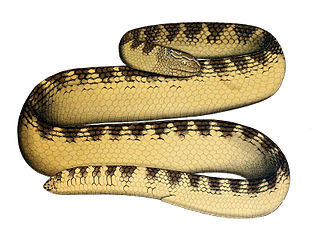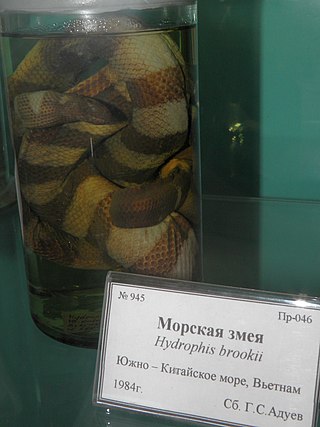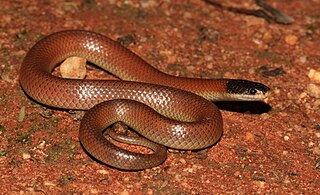
Elapidae is a family of snakes characterized by their permanently erect fangs at the front of the mouth. Most elapids are venomous, with the exception of the genus Emydocephalus. Many members of this family exhibit a threat display of rearing upwards while spreading out a neck flap. Elapids are endemic to tropical and subtropical regions around the world, with terrestrial forms in Asia, Australia, Africa, and the Americas and marine forms in the Pacific and Indian Oceans. Members of the family have a wide range of sizes, from the 18 cm (7.1 in) white-lipped snake to the 5.85 m king cobra. Most species have neurotoxic venom that is channeled by their hollow fangs, and some may contain other toxic components in various proportions. The family includes 55 genera with around 360 species and over 170 subspecies.

Sinomicrurus macclellandi, commonly known as MacClelland's coral snake, is a species of venomous snake in the family Elapidae. The species is endemic to southern and eastern Asia.

Aipysurus eydouxii, commonly known as the beaded sea snake, the marbled seasnake, and the spine-tailed seasnake, is a species of venomous snake in the family Elapidae. A. eydouxii is unusual amongst sea snakes in that it feeds almost exclusively on fish eggs. As part of this unusual diet, this species has lost its fangs, and the venom glands are almost entirely atrophied.

Hydrophis brookii is a species of venomous sea snake in the subfamily Hydrophiinae of the family Elapidae. The species is native to bodies of water in Southeast Asia.

Hydrophis melanocephalus, commonly known as the slender-necked sea snake, is a species of venomous sea snake in the family Elapidae.

The yellow-lipped sea krait, also known as the banded sea krait or colubrine sea krait, is a species of venomous sea snake found in tropical Indo-Pacific oceanic waters. The snake has distinctive black stripes and a yellow snout, with a paddle-like tail for use in swimming.

The blue-lipped sea krait, also known as the blue-banded sea krait or common sea krait, is a species of venomous sea snake in the subfamily Laticaudinae of the family Elapidae. It is found in the Indian and Western Pacific Oceans.
Hydrophis cantoris, also known commonly as Cantor's narrow-headed sea snake and Cantor's small-headed sea snake, is a species of venomous sea snake in the family Elapidae.

Sea snakes, or coral reef snakes, are elapid snakes that inhabit marine environments for most or all of their lives. They belong to two subfamilies, Hydrophiinae and Laticaudinae. Hydrophiinae also includes Australasian terrestrial snakes, whereas Laticaudinae only includes the sea kraits (Laticauda), of which three species are found exclusively in freshwater. If these three freshwater species are excluded, there are 69 species of sea snakes divided between seven genera.
Hydrophis semperi, commonly known as the Lake Taal snake, Garman's sea snake, the Philippine freshwater sea snake, and the Luzon sea snake, is a rare species of venomous sea snake found only in a single lake on the island of Luzon in the Philippines. It is noted for being one of two known species of sea snakes that are known to be found almost-exclusively in freshwater. The other freshwater sea snake species is Laticauda crockeri.

Aipysurus laevis is a species of venomous sea snake found in the Indo-Pacific. Its common names include golden sea snake, olive sea snake, and olive-brown sea snake.

Sea kraits are a genus of venomous elapid sea snakes, Laticauda. They are semiaquatic, and retain the wide ventral scales typical of terrestrial snakes for moving on land, but also have paddle-shaped tails for swimming. Unlike fully aquatic ovoviviparous sea snakes, sea kraits are oviparous and must come to land to digest prey and lay eggs. They also have independent evolutionary origins into aquatic habitats, with sea kraits diverging earlier from other Australasian elapids. Thus, sea kraits and sea snakes are an example of convergent evolution into aquatic habitats within the Hydrophiinae snakes. Sea kraits are also often confused with land kraits , which are not aquatic.

The black-banded sea krait, also known commonly as the Chinese sea snake or erabu, is a species of venomous snake in the subfamily Laticaudinae of the family Elapidae. In Japan it is known as erabu umi hebi, and in Okinawa as the irabu. It is found in much of the western Pacific Ocean.

Crocker's sea snake is a species of venomous snake in the subfamily Laticaudinae of the family Elapidae. The species is native to Oceania.

Dwyer's snake also known commonly as the whip snake and the variable black-naped snake, is a species of venomous snake in the family Elapidae. The species is endemic to Australia, where it is found from New South Wales to South Queensland. While closely related to Australian sea snakes, S. dwyeri is a terrestrial reptile.

Goldie's tree cobra, also known commonly as the African tree cobra and as Gold's tree cobra, is a species of venomous tree cobra in the family Elapidae. The species is native to Central and Western Africa. This species is one of the two tree cobras in Africa, the other being the black tree cobra. Goldie's tree cobra is one of the most venomous snakes and creatures in Africa.
Aipysurus duboisii, also known commonly as Dubois' sea snake and the reef shallows sea snake, is a species of extremely venomous snake in the subfamily Hydrophiinae of the family Elapidae. Its geographic range includes Papua New Guinea, New Caledonia and the northern, eastern and western coastal areas of Australia, that is the Coral Sea, Arafura Sea, Timor Sea and Indian Ocean. It lives at depths up to 80 meters in coral reef flats, sandy and silty sediments which contain seaweed, invertebrates and corals or sponges that can serve as shelter. It preys upon moray eels and various fish that live on the seafloor, up to 110 cm in size. A. duboisii is viviparous, giving birth to live young rather than laying eggs. It displays medium aggressiveness, i.e., will bite if provoked, but not spontaneously. The fangs are 1.8 mm long, which are relatively short for a snake, and the venom yield is 0.43 mg. Aipysurus duboisii is a crepuscular species, meaning that it is most active at dawn and dusk.

The yellow-bellied sea snake is a venomous species of snake from the subfamily Hydrophiinae found in tropical oceanic waters around the world except for the Atlantic Ocean. For many years, it was placed in the monotypic genus Pelamis, but recent molecular evidence indicates it lies within the genus Hydrophis.

The New Caledonian sea krait is a species of venomous snake in the subfamily Laticaudinae of the family Elapidae. The species is native to the waters around New Caledonia.
Laticauda guineai is a species of venomous sea snake in the family Elapidae. The species, which was first described by Heatwole, Busack and Cogger in 2005, is native to waters off southern New Guinea.
















